
Robust, comfy and versatile, the update to this alpine pack range retains its original close fit and handy chest pockets, features influenced by running vest design. It's this that really sells it, reckons Dan Bailey.
With their Trion range, Mammut were early adopters of the idea that climbing packs could benefit from the influence of running vests, in terms of a body-hugging low-profile harness, and stretchy shoulder pockets for easy on-the-go access to snacks, phone, and soft flasks. I'm increasingly of the opinion that most rucksacks would be better built along these lines, and would definitely count myself as a Trion fan ever since I tried one on (sorry).
The range has been updated for this year, and comes in a number of shapes and sizes, from the minimalist fast-and-light Trion 15, via a 28 and 38 - both good options for all-round use - to the gear-toting Trion 50, which looks like the one for backpacking, hut tours and extended mountaineering journeys.
We reviewed a previous model in this series some years ago, the Trion Nordwand 38, and found a lot to like. In fact it's been a firm favourite ever since, from year-round walking and summer mountain rock to winter mountaineering (it's a bit small for full-on Scottish winter climbing loads). The new 28 not only shares the looks, but also a lot of the features we got on so well with before, especially the well-vented back system and close-fitting shoulder straps that give a nod to running vest design. It's a smaller pack of course, and does without the lid pocket that larger models in the series offer. A few other details are new too.
What's it for?
Mammut describe the Trion as an alpine backpack, and I think they mean that quite broadly since it's equally useful for walking, climbing, and even ski touring. My old Trion 38 remains a regular year-round companion on the hills of Scotland. I find the body-hugging, unrestrictive fit great for scrambling and winter mountaineering, while the back system has the sort of airy feel you need for summer comfort.
It's light enough for your average generalist user - if not runners and serious weight watchers - but also sufficiently sturdy and supportive to carry heavier loads in comfort, be that a rope and rack in summer or axe, crampons and extra layers in winter. With its smaller volume the Trion 28 suits less gear-intensive trips, and I can see it being equally useful for summer alpinism, year-round hillwalking, or lightly-equipped Scottish mountaineering days in any season. It would be spot on for a summer Cuillin traverse, for example (fairly generous for a one-day outing, big enough for a bivvy if you're super-disciplined about packing light).
Weight and durability
At 1030g on the home scales (Mammut say 1000g) the Trion 28 is not really lightweight by modern standards, more a midweight perhaps. It's 40% bigger or so, but it weighs well over twice as much as Rab's Latok 20, for example, another running-vest-inspired climbing pack I reviewed recently. It's possible to shed 69g by removing the padded section of the hip belt (an option larger users in particular will probably want to take) and a further 122g if you take out the wire frame. Even still, the Trion might not be your first choice for genuinely weight-critical occasions, but in its favour offers that bit more support and comfort than an outright minimalist pack would be likely to.
It's really well made too. After a lot of use my old Trion 38 is still going strong, with no hint of wear or damage. Its burly ripstop fabric is really abrasion-resistant, and shrugs off rain well too, so while the seams and entries aren't water-resistant, and you've go to pack stuff in drybags in changeable UK conditions, the overall feel is a pack that can take plenty of abuse and a fair bit of weather.
Fit and comfort
Both a men's and a women's model are available, at a back length of 46cm and 43.5cm respectively. As with most climbing packs the Trion 28 has no adjustability, so it'll either fit you or it won't. It's a small pack and the back length is understandably pretty short, so at 183cm tall and with a fairly long back I'm way too big for the hipbelt to do its job - on me it's a belly belt. I detached the padded section of hip belt straight away, which leaves just a webbing band. This cannot be removed, but is easily wrapped around the pack if you don't want to use it - I generally wouldn't on a rucksack this small, though perhaps it does marginally help to stabilise things.
For load-carrying support Mammut have included a light wire frame, and I don't think it's worth removing this since it makes for a comfier feel. A foam back sheet protects you from jutting items in the pack, while the additional padding is sensibly minimalist and really airy for hot weather comfort. Arm movement is unrestricted, courtesy of nicely sculpted shoulder straps; these have padding only over the shoulders - the weight-bearing part - while down over the chest it's a broad mesh strap, which hugs the body in the way a running vest does, for a close fit and maximum breathability. Again, like a running vest, the chest clip is on elastic, which is supportive enough to hold everything firm while also feeling comfy and forgiving.
Overall, and bearing in mind it's too short on me for the hipbelt to work as intended, I find the close fit of the Trion 28 hard to fault. It's supportive enough when walking with a heavy pack, and offers unrestricted movement when climbing or scrambling. By the standards of a climbing pack it's really well vented too. I think key to its success is the running vest influence. This is the main reason I keep returning to the old Trion 38, and so far I'm equally happy with the new version.
Features
As noted, this is a lidless design, so if you want a lid pocket (I do tend to use them a lot) then go for a Trion 38 or 50. Closure is via a rolltop, with an additional zip - the point of which is presumably to allow you to stuff things right to the gunwales. You get a top rope strap too, which given the limited internal space is likely to see a lot of use.
Mammut have added a side zip, so you can access the contents of the pack without fiddling with the rolltop. I'm sceptical of side zips on smaller packs, and think they're really only becoming useful at trekking pack size. On a 28L bag I definitely consider this surplus to my needs since it's really no big deal to root around from the top. The side zip is just something I might forget to leave closed, or a handy way for rain to get in. Naturally they have their fans, and perhaps you're one of them.
Inside is one small mesh valuables pocket with a key clip, plus the usual water bladder sleeve. For skiers there's an additional zipped compartment to stow avalance equipment; for other purposes, this might be a place to slip a map or a light shell. The stretchy chest pockets are the big plus for me, and I use them every time I'm out, for on-the-move access to snacks, phone and drinks. At a squeeze they'll just hold a 500ml soft flask though ideally they could be a couple of centimetres deeper, so I more often go with a 250ml bottle.
Daisychains give you extra places to clip things, while the axe and pole attachments are nice and simple. The addition of reinforced loops for skis increases the Trion's all-mountain versatility. For attaching a roll mat or suchlike the compression straps are usefully long, and can be wrapped around the pack to allow you to carry bulky items on the back as well as at the sides. My one issue with these is that there's no really neat way to secure the lengthy tails of webbing, which tend to hang loose and flap around in the wind; the Trion is quite 'strappy'.
Ethics and environment
Environmental credentials are pretty solid: The Trion is made primarily of recycled materials, and features a PFC-free DWR. It's also Bluesign and Fair Wear-certified.

















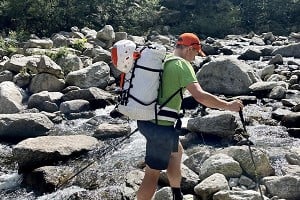










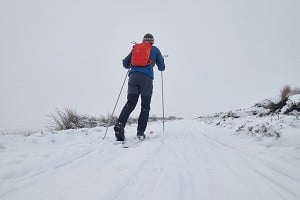

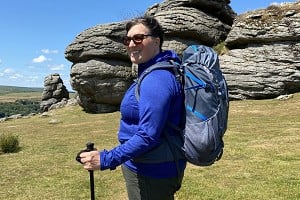






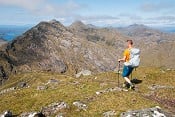




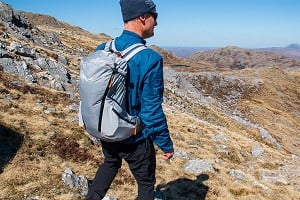


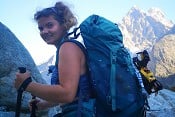

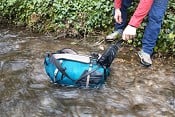
Comments
I think you missed "Cons: Price". I know it's not the most expensive pack out there (*cough* *cough* BD Beta Light 30) but the price is significantly higher than a lot of similar packs.
For example, Alpkit Idris 25L has similar fit and features, is 40%+ lighter, and is less than half the RRP. OMM have similar packs for much less, and I'm sure I could find many more. Ice axe attachment is one difference, but for the difference in price I could just add some ties/bungee myself. Based on this review, I'm not seeing the justification for the higher price point (other than the lovely mammoth logo of course).
Of course you can find cheaper rucksacks. But I don't think £155 is excessive in this current inflationary economy. It's a quality pack - over the last few years I've had absolutely loads of use out of its predecessor and it still shows no sign of wear.
Your cheaper example has some similarities in the sense that it's a rolltop with a degree of running vest influence. But there the similarities seem to end.
I'd bet it isn't as tough. As you acknowledge, it has no axe attachment. No rope strap either. And I'd imagine no internal frame. And no removable hip padding. So it's not directly equivalent at all really. It look more a running/walking pack, whereas the Trion is first and foremost a climbing pack, with a running influence, that's also good for walking. Apples and pears.
So I'm not listing its price as a con, that would be unfair.
Maybe I'm just thriftier than others, but I still think that £155 is a pretty high RRP for a small pack.
Perhaps a fairer comparison would be to the Blue Ice Firecrest 28, Black Diamond Blitz 28, or Rab Latok 28, all of which are climbing specific, all of which have lower RRPs, and all of which weigh less.
The obvious trade-off for the weight is durability, which you're vouching for based on your experience with your older Trion 38. However, it looks like the material may have changed since then. I couldn't find a lot of information about the material, but what I could find was the older model was "100% polyamide", and the newer model has "Main material 90% polyamide, 10% polyester". We know the even a small change in fabric composition can completely change its performance. Do you have more information on the materials to confirm if they are actually the same composition and weight?
The other reason I might go for the more expensive Mammut is if the fit is super comfortable. The best thing to do would be try one on, but the reality is that I don't have anywhere in reasonable traveling distance that would ever stock such a specialist pack, so I'm always going to be ordering online. Other packs (e.g. Firecrest) do come in different sizes. You mention that the pack is too short for you and that the waist belt becomes a "belly belt", but also that you find the fit "hard to fault". So, does that mean you're still ok with the short fit or not?
I'm being hypercritical here because I'm really interested in this pack. You may not think the price is high enough to be a negative, but it's certainly a factor I need to strongly consider. The high-end price point is justifiable if the pack lives up to it, but there seems to be a fair number of reasons to give me pause: ambiguity over weight vs. durability, ambiguity over fit, unnecessary zips that could reduce water resistance (I agree on the side zip being surplus), untidy straps, and possibly too-small chest pockets.
The Trion 38 I have is made from very undurable fabric, but is very light, and was very much designed as a ski touring pack/alpine snow climbing. So if the fabric changed for a use and abuse climbing pack that is an improvement. So it’s clear different generations of Trion can’t be directly compared.
But in reality anyone wanting a robust small pack for fine days could pick up a karrimor hot rock or similar on eBay, save themselves a chunk of change for other gear and have a sac with a two decade life span. Plus would be more environmentally sustainable.
There's no way I'd pay £155 for a small rucksack when you can get something like the Simond Sprint 22L for a third of the price and weight.
I've had an earlier version of the Sprint for 10 years and only needed to replace it this year.